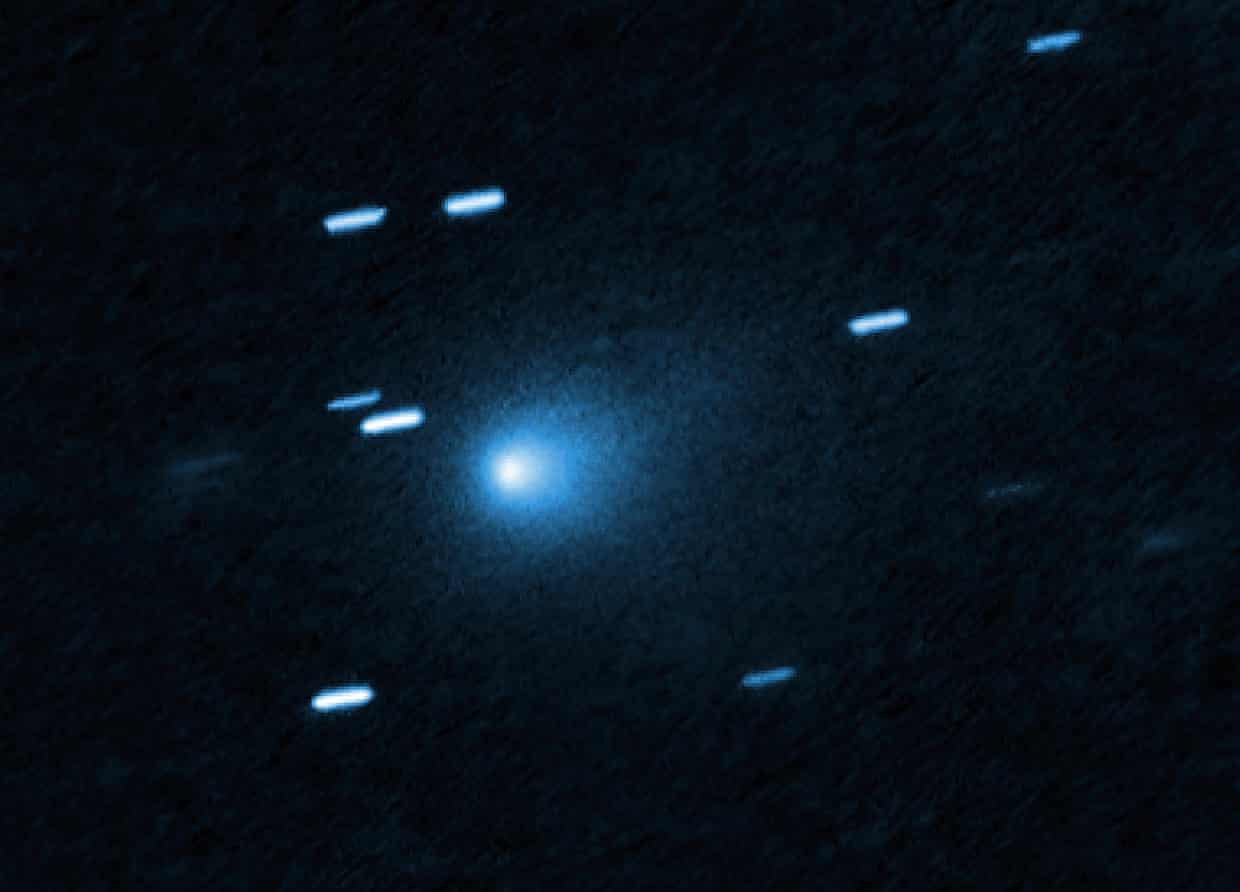Science
Scientists Excited as Comet 3I/Atlas Approaches the Sun

A comet from beyond our solar system, designated as 3I/Atlas, is racing towards the sun at an impressive speed of approximately 61 kilometers (38 miles) per second. Detected first in July 2023, this celestial object is only the third known interstellar visitor, following ‘Oumuamua in 2017 and 2I/Borisov in 2019. The Hubble Space Telescope has recently captured images of 3I/Atlas, sparking significant excitement among scientists eager to analyze its size and composition.
Scientists are particularly intrigued by 3I/Atlas because it presents a unique opportunity to study an object that has originated from outside the solar system. Dr. Rebecca Allen, co-director of Swinburne’s Space Technology and Industry Institute, noted, “We’ve never had an object like this to study before.” Dr. Laura Driessen, a radio astronomer at the University of Sydney, emphasized the mysterious nature of the comet’s origin, stating, “We don’t know exactly where it came from, but it definitely came from outside the solar system.”
The designation of 3I/Atlas comes from the scientific nomenclature where “i” stands for interstellar, “3” indicates it is the third such object detected, and “Atlas” refers to the network of telescopes that identified it, known as the Asteroid Terrestrial-impact Last Alert System. While some have speculated about the potential for alien origins, scientists largely agree that 3I/Atlas is likely a comet rather than an extraterrestrial craft. Dr. Driessen remarked, “There’s no evidence to point towards [3I/Atlas] being anything other than a really fun space rock that came from outside the solar system, which, to be honest, is cool enough.”
Characteristics and Trajectory of 3I/Atlas
In images captured by the Hubble, 3I/Atlas appears somewhat like a “fuzzy snowball,” a description provided by Dr. Allen. This appearance is due to a “coma” that forms as the comet’s surface heats up in proximity to the sun, releasing dust and gas. Preliminary analyses indicate that as the comet approaches the sun, chemical signatures of elements and molecules from beyond our solar system will become more apparent. “We can use a tool called spectroscopy, and we can use light to actually understand exactly what that material is,” Dr. Allen explained.
Researchers have estimated the diameter of 3I/Atlas to be less than 5.6 kilometers, with some estimates suggesting it could be as small as 320 meters. The comet is currently traveling at over 200,000 kilometers per hour and is expected to pass between the orbits of Mars and Earth before making its closest approach to the sun between October and December 2023. At its closest, it will come within approximately 210 million kilometers of the sun, and the closest approach to Earth will be about 270 million kilometers, as reported by NASA.
Con Stoitsis, the comet and meteor director at the Astronomical Society of Victoria, highlighted that 3I/Atlas is on a hyperbolic orbit, meaning it is not gravitationally bound to the sun and will continue on its path out of the solar system. “We’re not really sure where it’s going to end up until it comes around from the other side of the sun and starts heading out to the outer solar system again,” Stoitsis stated.
Viewing Opportunities and Expectations
As for visibility, 3I/Atlas is currently quite faint but is expected to brighten as it approaches the sun. Stoitsis noted that it should eventually become observable with most large amateur telescopes. However, he cautioned that even then, it may only appear as a smudge in the sky. “We get bright-ish comets, three or four times a year, which are visible with small telescopes and binoculars. This is definitely not one of those,” he explained. “Unless you’ve got a decent-sized telescope, you won’t see it.”
The arrival of 3I/Atlas presents an exciting opportunity for scientists and amateur astronomers alike, as they prepare to observe this extraordinary interstellar visitor and glean insights into the building blocks of our universe.
-

 World5 months ago
World5 months agoSBI Announces QIP Floor Price at ₹811.05 Per Share
-

 Lifestyle5 months ago
Lifestyle5 months agoCept Unveils ₹3.1 Crore Urban Mobility Plan for Sustainable Growth
-

 Science4 months ago
Science4 months agoNew Blood Group Discovered in South Indian Woman at Rotary Centre
-

 World5 months ago
World5 months agoTorrential Rains Cause Flash Flooding in New York and New Jersey
-

 Top Stories5 months ago
Top Stories5 months agoKonkani Cultural Organisation to Host Pearl Jubilee in Abu Dhabi
-

 Sports4 months ago
Sports4 months agoBroad Advocates for Bowling Change Ahead of Final Test Against India
-

 Science5 months ago
Science5 months agoNothing Headphone 1 Review: A Bold Contender in Audio Design
-

 Top Stories5 months ago
Top Stories5 months agoAir India Crash Investigation Highlights Boeing Fuel Switch Concerns
-

 Business5 months ago
Business5 months agoIndian Stock Market Rebounds: Sensex and Nifty Rise After Four-Day Decline
-

 Sports4 months ago
Sports4 months agoCristian Totti Retires at 19: Pressure of Fame Takes Toll
-

 Politics5 months ago
Politics5 months agoAbandoned Doberman Finds New Home After Journey to Prague
-

 Top Stories5 months ago
Top Stories5 months agoPatna Bank Manager Abhishek Varun Found Dead in Well









